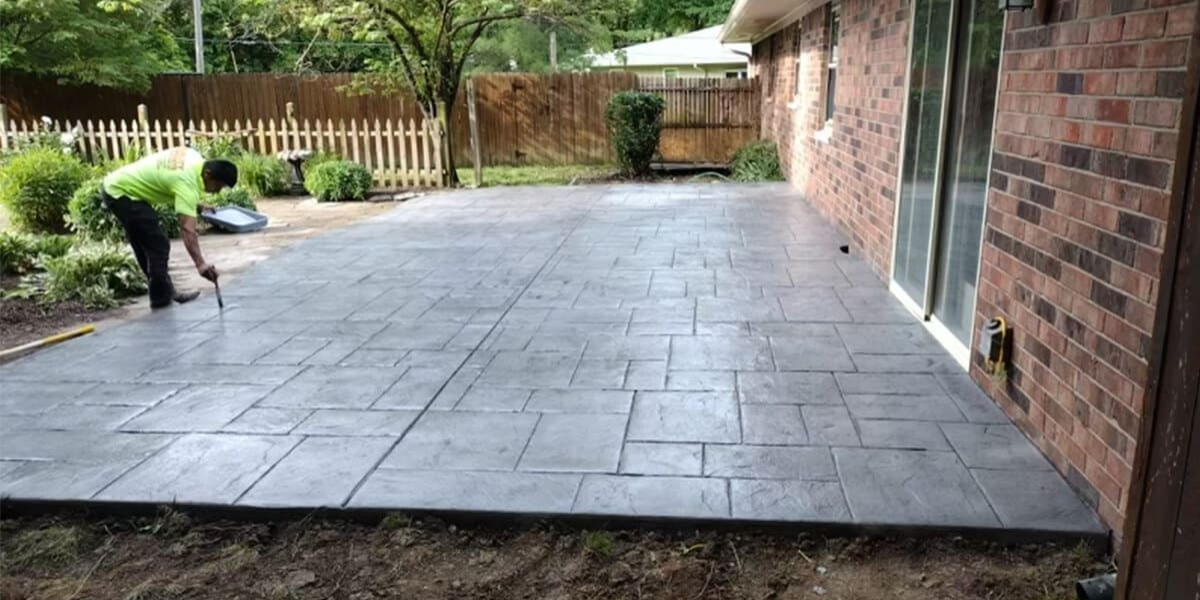A concrete patio is a long-term investment that should add comfort, value, and low-maintenance outdoor living to your home. The right contractor will help you get there with clear answers, solid processes, and written guarantees. Before you sign anything, ask the five questions below. You’ll quickly separate true pros from guesswork.
1) What Experience Do You Have With Patios Like These?
Why This Matters
Residential patios need different workmanship than driveways or interior slabs. Experience with patios means your contractor understands site grading near foundations, finish options (such as broom, exposed aggregate, or stamped), and neighborhood permitting requirements.
How To Evaluate The Answer
Request recent, local references and photos of completed patios of a similar size and style. Confirm they handled subgrade prep, formwork, and finishes, not just the pour. A reputable crew will gladly share addresses, timelines, and a point of contact.
Red Flags
Vague portfolios, no local jobs, or hesitation to provide references. If they only show far-away projects or stock images, keep looking.
2) What Mix, Reinforcement, And Thickness Do You Recommend, And Why?
Expect Specifics
For most residential patios, a 4-inch slab is standard when placed over a properly compacted base. Ask about the specified compressive strength (often 3,500–4,000 psi for patios), air entrainment in freeze-thaw zones, and water-cement ratio control at the truck. These details help with durability and finish quality.
Reinforcement Options
Contractors may recommend welded wire mesh, rebar in a grid, or synthetic fibers. Fibers help reduce early-age (plastic) shrinkage cracking, but do not replace structural steel when loads demand it. A competent pro will explain what they’re using and where.
Drainage-Safe Placement
Near the house, patios should slope away to move water. Many building programs and codes require approximately 2% (¼ inch per foot) within the first 10 feet of the foundation. Ask how your contractor will establish and verify the slope with strings, lasers, or levels.
3) How Will You Prepare The Subgrade, Control Drainage, And Place Joints?
Subgrade And Base
Quality starts under the slab. Your contractor should remove topsoil and organic material, install a well-graded, compacted granular base, and proof-roll soft spots. Compaction testing isn’t overkill for expansive or wet soils.
Water Management
Ask about planned slopes, downspout extensions, and any drains or borders needed to prevent water from ponding. If trenching is required, confirm who is responsible for calling 811 for utility locates before commencing the digging process.
Joint Layout
Control joints manage inevitable concrete shrinkage. For a 4-inch patio, many pros aim to space joints roughly 8–12 feet apart and keep panels as square as possible. Joints should be cut to about one-quarter of the slab depth, timed soon after finishing to prevent random cracks. Request a simple sketch of the joint plan before the concrete is poured.
Third-Quarter Check-In (Your Local Option)
When comparing concrete patio contractors in Columbia Station, Ohio, consider Clean Custom Concrete for a site-specific joint layout, proper base preparation, and a written plan for drainage and curing.
4) What’s The Timeline, Warranty, And Curing Plan?
Timeline You Can Understand
A clear schedule covers demo (if needed), base prep, forming, pour day, saw-cut timing, and sealing. Weather cushions should be built in. Ask who will be on-site supervising each step.
Curing And Early Use
Curing is essential to reduce cracking and reach design strength. Expect guidance such as keeping the slab moist or using a curing compound, avoiding heavy loads for the first week, and protecting the surface from early freeze or scorching sun. Light foot traffic is typically allowed after the initial set, but furniture or grills may need to wait several days; vehicles should never park on a standard patio.
Warranty In Writing
Look for workmanship coverage (often 1 year) and clarity about what’s excluded (e.g., hairline shrinkage cracks, damage from de-icing salt). The warranty should name the sealer type and re-seal interval, if applicable.
Aftercare Basics
Get a short care sheet: when to wash, when to seal, how to deal with winter de-icers (avoid chloride salts), and how to manage heavy planters to prevent surface marks.
5) Can You Provide A Clear, Itemized Estimate And Contract?
What To See On Paper
Your estimate should separate labor, materials, base thickness, slab thickness, reinforcement, finish type, sealer, saw-cut joints, disposal fees, permits, and any drainage components. This protects you from change-order surprises.
Insurance, Licensing, And References
Request proof of liability and workers’ comp, confirm local licensing, and collect two recent references to call.
Payment Terms
Avoid large upfront deposits. A fair structure ties payments to milestones, including mobilization, after pour, and final payment after joint cutting and cleanup. Ensure change orders are written and signed.
Final Thoughts
The right contractor welcomes informed questions. Focus on demonstrated patio experience, material, and reinforcement choices matched to your site, proven drainage and jointing practices, a realistic schedule with curing steps, and a clean, itemized contract. With those boxes ticked, and everything in writing, you’ll set up your project for a durable, attractive patio that’s easy to own.
Ready to create a build plan? When screening concrete companies in Columbia Station, choose a contractor like Clean Custom Concrete. The experts will answer essential questions, provide a joint layout sketch, and give curing instructions before the pour, ensuring your patio lasts for years.



